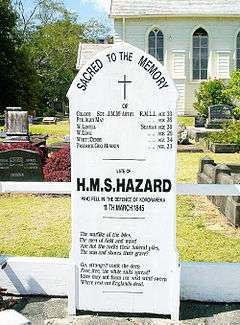HMS Hazard (1837)
| History | |
|---|---|
| Name: | HMS Hazard |
| Ordered: | 10 June 1823 |
| Builder: | Portsmouth Dockyard |
| Cost: | £10,500 |
| Laid down: | May 1829 |
| Launched: | 21 April 1837 |
| Completed: | 5 July 1837 |
| Fate: | Broken up by 12 February 1866 |
| General characteristics | |
| Class and type: | 18-gun Favorite-class sloop |
| Tons burthen: | 431 bm[1] |
| Length: |
|
| Beam: | 30 ft 9 in (9.37 m) |
| Depth of hold: | 12 ft 9 in (3.89 m) |
| Sail plan: | Full-rigged ship |
| Complement: | 125 |
| Armament: |
|
HMS Hazard was an 18-gun Favorite-class sloop of the Royal Navy. She was one of four Favorite-class ship sloops, which were a ship-rigged and lengthened version of the 1796 Cruizer-class brig-sloop. All four ships of the class were ordered on 10 June 1823. She was launched in 1837 from Portsmouth Dockyard.
Service off West Africa and in the Mediterranean
In July 1837 Hazard sailed for the coast of Senegal to protect British shipping and to patrol the coast of West Africa. In October 1837 she was in the Mediterranean. She took part in the Egyptian–Ottoman War (1839–1841), also known as the Second Syrian War, when the British Mediterranean Fleet under Admiral Sir Robert Stopford, supported the Ottoman Empire and took action to compel the Egyptians to withdraw from Beirut. During the Oriental Crisis of 1840 Hazard was involved in the bombardment of St. Jean d’Acre on 3 November 1840.
First Anglo-Chinese War
In September 1841, she returned to Portsmouth then sailed to Hong Kong to serve in the East Indies and China Station. During the period 1841–42 she served with Sir William Parker's ships in the First Anglo-Chinese War (1839–42),[2] known popularly as the First Opium War.
Service in the First Māori War in New Zealand
.jpg)

Hazard, under Acting-Commander Robertson, operated in the Bay of Islands in New Zealand during the Flagstaff War in 1845. Hazard was in the Bay of Islands on 11 March 1845 when a force of about 600 Māori armed with muskets, double-barrelled guns and tomahawks attacked Kororareka (as Russell was then known). Royal Marines and sailors from Hazard took part in the fighting ashore aiding a detachment of the 96th Regt. during the Battle of Kororāreka. The Hazard lost 6 men killed and 8 wounded.[3] Lieutenant George Philpotts ordered the bombardment of Kororāreka.[4] The next morning, all surviving inhabitants of Kororareka sailed for Auckland in the Hazard.
On 30 June 1845 a small naval brigade from both HMS Hazard and HMS North Star supported the 58th Regt. and other colonial forces at the Battle of Ohaeawai. The colonial forces were repulsed by Māori warriors with serious losses including Lieutenant George Phillpotts.[5][6]
Further service in the East Indies and China Station
In November 1845 HMS Hazard sails from the Bay of Islands, for Hong Kong. In April 1846 she was part of a squadron supporting Sir James Brooke (Raja Brooke of the Kingdom of Sarawak) in suppressing insurgency in the Sultanate of Brunei.
She was reduced to 14 guns in 1848, and was eventually broken up at the yards of J. Samuel White, Cowes by 12 February 1866.
References
- ↑ Colledge, p. 159
- ↑ "HMS HAZARD (Anglo-Chinese war 1842)". Retrieved 23 December 2012.
- ↑ "New Zealander" (1) (1 ed.). 7 June 1845. p. 2.
- ↑ "The sacking of Kororareka". Ministry for Culture and Heritage – NZ History online. 3 April 2009. Retrieved 23 December 2012.
- ↑ Carleton, Hugh (1874). Vol II, The Life of Henry Williams. Early New Zealand Books (ENZB), University of Auckland Library. p. 112.
- ↑ Cowan, James (1922). "Chapter 8: The Storming-Party at Ohaeawai". The New Zealand Wars: a history of the Maori campaigns and the pioneering period, Volume I: 1845–1864. Wellington: R.E. Owen. p. 61.
Sources
- Colledge, J. J.; Warlow, Ben (2006) [1969]. Ships of the Royal Navy: The Complete Record of all Fighting Ships of the Royal Navy (Rev. ed.). London: Chatham Publishing. ISBN 978-1-86176-281-8. OCLC 67375475.
- Winfield, Rif & Lyon, David (2004). The Sail and Steam Navy List: All the Ships of the Royal Navy 1815–1889. London: Chatham Publishing. ISBN 978-1-86176-032-6. OCLC 52620555.